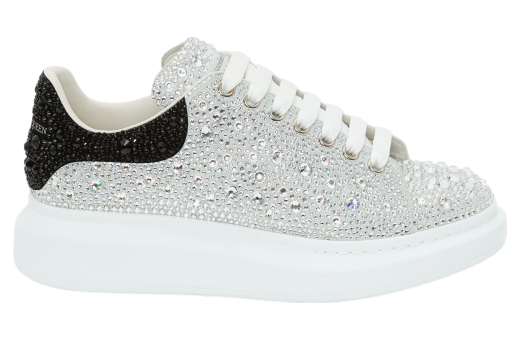Alexander Mcqueen
Alexander McQueen sneakers have carved a niche in the world of contemporary fashion, blending high-end luxury with streetwear sensibility. These sneakers are instantly recognizable by their exaggerated, oversized soles that not only provide a unique aesthetic but also superior comfort. Made from premium materials such as calf leather, they exude elegance while ensuring durability and a premium foot feel. The sneakers often feature minimalist design elements, reflecting a sleek and modern look that can complement a variety of outfits—from casual jeans to more polished ensembles. Signature branding, often displayed on the heel tab or the tongue, adds a touch of distinction, making it clear that these are not just any ordinary sneakers.
The appeal of Alexander McQueen sneakers extends beyond their visual and tactile allure. They symbolize a fusion of bold innovation and timeless craftsmanship, hallmarks that fans of the brand have come to appreciate. For many, owning a pair is akin to possessing a piece of wearable art, a testament to Alexander McQueen's legacy of pushing fashion boundaries. The versatility of these sneakers enhances their desirability; they can transition effortlessly from day to night, making them a valuable addition to any wardrobe. In a marketplace crowded with footwear options, Alexander McQueen sneakers stand out for their distinctive design, quality construction, and the prestige they carry.
History of Alexander Mcqueen
Alexander McQueen: A Visionary in Fashion History
Lee Alexander McQueen, known to the world as Alexander McQueen, was a British fashion designer renowned for his innovative, provocative, and often controversial designs. His work combined a deep historical knowledge with a modern sensibility, making him one of the most influential figures in the fashion industry. His life's journey from a humble background to a fashion icon is a tale of extraordinary talent, determination, and a relentless quest for beauty and meaning.
Early Life and Genesis of a Talent
Born on March 17, 1969, in Lewisham, London, Alexander McQueen was the youngest of six children. His father, Ronald McQueen, was a taxi driver, and his mother, Joyce McQueen, was a social science teacher. From an early age, McQueen showed an interest in fashion, often creating dresses for his three sisters. Encouraged by his family's recognition of his nascent talent, he left school at 16 to begin an apprenticeship on Savile Row, the renowned street for bespoke tailoring in London's Mayfair district.
McQueen's apprenticeship at the esteemed Anderson & Sheppard and later at Gieves & Hawkes honed his technical skills and meticulous attention to detail. These experiences ingrained in him a craftsmanship that would become a hallmark of his designs. His early work on Savile Row also introduced him to the theatricality of fashion, which would later become a significant aspect of his shows.
Education and Early Career
After completing his apprenticeship, McQueen worked with theatrical costume designers Angels and Bermans, a job that significantly influenced his later work, adding a theatrical and narrative element to his collections. Seeking to further his education, McQueen enrolled at Central Saint Martins College of Art and Design, one of the most prestigious fashion schools in the world.
At Central Saint Martins, he completed a Master's in Fashion Design, with his graduation collection in 1992 catching the eye of influential fashion stylist Isabella Blow. Blow was enthralled by McQueen’s collection, titled "Jack the Ripper Stalks His Victims," due to its dark, romantic, and historically inspired themes. She bought the entire collection and became one of his most fervent supporters and collaborators.
Birth of the Brand and Rise to Stardom
After his graduation, McQueen quickly established his brand, Alexander McQueen, and his early shows were characterized by their dramatic and often startling themes. His collections, such as "Highland Rape" (AW 1995) and "The Hunger" (SS 1996), explored themes of history, identity, and sexuality through a lens that was both contemporary and shocking. His work was often seen as a commentary on social issues, pushing boundaries and provoking thought.
In 1996, at the age of 27, McQueen was appointed the head designer at the French haute couture house Givenchy, following the departure of John Galliano. This appointment was both a testament to his prodigious talent and a significant leap for his career. McQueen's tenure at Givenchy was marked by a bold reinterpretation of the brand's classic elegance with his unique and often controversial aesthetic. Despite some criticism, his work continued to garner admiration and acclaim.
Signature Style and Innovations
McQueen's designs were a juxtaposition of seemingly contradictory elements: fragility and strength, tradition and modernism, fluidity and severity. His collections often drew on an eclectic mix of inspirations, including his Scottish heritage, historical events, and contemporary culture. His ability to weave narratives into his collections set him apart from his contemporaries.
One of his most notable contributions to fashion was his use of technology. In his Spring/Summer 1999 show, McQueen featured model Shalom Harlow wearing a white dress while robotic arms sprayed her with paint, creating a unique, live piece of art. In his final show, "Plato's Atlantis" (SS 2010), he employed high-tech fashion films and holographic projections, pushing the boundaries of what a fashion show could be.
McQueen's dedication to craftsmanship was legendary. His designs often featured intricate embroidery, expert tailoring, and innovative use of fabrics. He was known for his "bumster" trousers, which lowered the waistline of trousers to elongate the torso and challenge conventional ideas of beauty and sexuality. His skull motifs, sharp tailoring, and dramatic silhouettes became synonymous with his brand.
Awards and Recognitions
Throughout his career, McQueen received numerous accolades. He won the British Fashion Council's Designer of the Year award four times between 1996 and 2003. In 2003, he was awarded the CBE (Commander of the Order of the British Empire) and named International Designer of the Year by the Council of Fashion Designers of America. These honors reflected not only his technical brilliance and creativity but also his impact on and contributions to the fashion industry at large.
Dark Times and Personal Struggles
Despite his professional success, McQueen's life was marred by personal struggles. He was open about his battles with depression, which were exacerbated by the sudden death of Isabella Blow in 2007, his close friend and mentor. In 2010, the death of his beloved mother Joyce plunged him into further despair, and tragically, McQueen took his own life on February 11, 2010, at the age of 40.
His untimely death sent shockwaves through the fashion industry and beyond, mourning the loss of a man who had not only redefined fashion but had also pushed its boundaries in ways that were both profound and lasting. His death highlighted the intense pressures of the fashion industry and the toll it can take on creative minds.
Legacy and Lasting Impact
Alexander McQueen’s legacy continues to resonate within the fashion industry. His innovative designs and the narrative depth of his collections have inspired countless designers and artists. The retrospective "Alexander McQueen: Savage Beauty," which originated at the Metropolitan Museum of Art in New York in 2011 and later moved to the Victoria and Albert Museum in London, became one of the most popular fashion exhibits of all time, demonstrating the enduring allure of his work.
The brand he created continues to thrive under the creative directorship of Sarah Burton, who worked closely with McQueen for many years. Burton has maintained the house’s signature dramatic flair while infusing it with her own distinct sensibility. Her designs, including the wedding dress for Catherine Middleton's marriage to Prince William in 2011, have been celebrated for their elegance and innovation.
Additionally, McQueen's influence extends beyond fashion. His work intersects with art, performance, and technology, contributing to broader cultural conversations about identity, beauty, and power. His ability to challenge norms and provoke thought through fashion has left an indelible mark.
A Visionary Remembered
In remembering Alexander McQueen, it’s essential to consider both his remarkable professional achievements and his complex personal journey. He was a man of contradictions—a meticulous craftsman with a rebellious spirit, a visionary who drew deeply from the past to create the future, and an artist whose work was as much about the beauty of fashion as it was about confronting its darker undercurrents.
McQueen once said, "I find beauty in the grotesque, like most artists." This ethos permeated his work, driving him to explore themes others might shy away from and to find beauty in unexpected places. For McQueen, fashion was not just about clothing but about creating a narrative, evoking emotion, and challenging perceptions.
Conclusion
Alexander McQueen's contribution to fashion is immeasurable. He revolutionized fashion shows, turned clothes into art, and explored themes that challenged and provoked. His tenure at both his eponymous label and Givenchy left a lasting legacy of innovative design and dramatic storytelling.
Even after his death, the ripples of his creativity continue to influence new generations of designers. McQueen’s story is one of extraordinary talent and tragic struggle, reflecting both the heights of artistic achievement and the profound personal battles of the man behind the masterpieces. Alexander McQueen will forever be remembered as a true visionary whose impact on fashion history is both deep and enduring.























